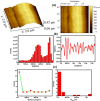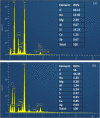Synergistic antibacterial activity of surfactant free Ag-GO nanocomposites
- PMID: 33420190
- PMCID: PMC7794585
- DOI: 10.1038/s41598-020-80013-w
Synergistic antibacterial activity of surfactant free Ag-GO nanocomposites
Abstract
Graphene oxide-silver (Ag-GO) nanocomposite has emerged as a vital antibacterial agent very recently. In this work, we report a facile one step route of Ag-GO nanocomposite formation excluding the aid of surfactants and reductants and was successfully applied to negative Escherichia Coli (E coli) to investigate antibacterial activity by varying doze concentration. The successful formation of Ag-GO nanocomposite via facile one step route was confirmed using Fourier transform infrared spectroscopy (FTIR) and Raman Spectroscopy. The absorption spectra (peak ~ 300 nm) for GO and the (peak ~ 420 nm) for silver nanoparticles were observed. XRD study confirmed the formation of Ag-GO nanocomposite while atomic force microscopy (AFM) showed crumbled GO sheets decorated with Ag nanoparticles. It was observed that the functional groups of GO facilitated the binding of Ag nanoparticles to GO network and enhanced the antibacterial activity of the nanocomposite.
Conflict of interest statement
The authors declare no competing interests.
Figures








Similar articles
-
Preparation, characterization, and antibacterial activity of silver nanoparticle-decorated graphene oxide nanocomposite.ACS Appl Mater Interfaces. 2015 Apr 1;7(12):6966-73. doi: 10.1021/acsami.5b00937. Epub 2015 Mar 18. ACS Appl Mater Interfaces. 2015. PMID: 25762191
-
Antibacterial properties of amino acid functionalized silver nanoparticles decorated on graphene oxide sheets.Spectrochim Acta A Mol Biomol Spectrosc. 2017 Jun 15;181:47-54. doi: 10.1016/j.saa.2017.03.032. Epub 2017 Mar 16. Spectrochim Acta A Mol Biomol Spectrosc. 2017. PMID: 28329722
-
Tobramycin mediated silver nanospheres/graphene oxide composite for synergistic therapy of bacterial infection.J Photochem Photobiol B. 2018 Jun;183:342-348. doi: 10.1016/j.jphotobiol.2018.05.009. Epub 2018 May 7. J Photochem Photobiol B. 2018. PMID: 29763756
-
Preclinical functional characterization methods of nanocomposite hydrogels containing silver nanoparticles for biomedical applications.Appl Microbiol Biotechnol. 2020 Jun;104(11):4643-4658. doi: 10.1007/s00253-020-10521-2. Epub 2020 Apr 6. Appl Microbiol Biotechnol. 2020. PMID: 32253473 Review.
-
Silver-dendrimer nanocomposite as emerging therapeutics in anti-bacteria and beyond.Drug Resist Updat. 2023 May;68:100935. doi: 10.1016/j.drup.2023.100935. Epub 2023 Jan 29. Drug Resist Updat. 2023. PMID: 36774747 Review.
Cited by
-
Hyaluronic acid-g-lipoic acid granular gel for promoting diabetic wound healing.Bioeng Transl Med. 2022 Sep 14;8(2):e10402. doi: 10.1002/btm2.10402. eCollection 2023 Mar. Bioeng Transl Med. 2022. PMID: 36925704 Free PMC article.
-
A Novel Green Preparation of Ag/RGO Nanocomposites with Highly Effective Anticancer Performance.Polymers (Basel). 2021 Sep 30;13(19):3350. doi: 10.3390/polym13193350. Polymers (Basel). 2021. PMID: 34641166 Free PMC article.
-
Antibiofouling Activity of Graphene Materials and Graphene-Based Antimicrobial Coatings.Microorganisms. 2021 Aug 30;9(9):1839. doi: 10.3390/microorganisms9091839. Microorganisms. 2021. PMID: 34576733 Free PMC article. Review.
-
Impaired Biofilm Development on Graphene Oxide-Metal Nanoparticle Composites.Nanotechnol Sci Appl. 2024 Dec 24;17:303-320. doi: 10.2147/NSA.S485841. eCollection 2024. Nanotechnol Sci Appl. 2024. PMID: 39734361 Free PMC article.
-
Synthesis, Characterization, and Evaluation of Antimicrobial Efficacy of Reduced Graphene-ZnO-Copper Nanocomplex.Antibiotics (Basel). 2023 Jan 25;12(2):246. doi: 10.3390/antibiotics12020246. Antibiotics (Basel). 2023. PMID: 36830156 Free PMC article.
References
MeSH terms
Substances
LinkOut - more resources
Full Text Sources
Other Literature Sources
Miscellaneous

